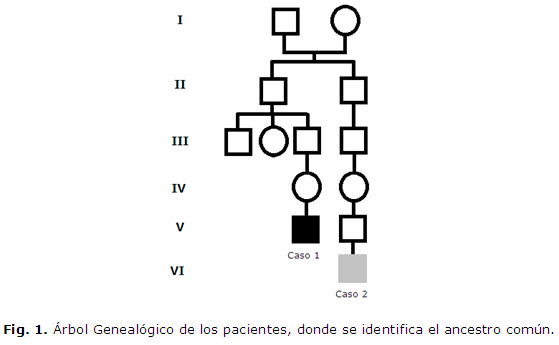Poland sequence: case reports of familial recurrence
Keywords:
Poland sequence/sequence/etiology/genetics.Abstract
Introductión: Poland sequence is a rare set of congenital defects characterized by total or partial agenesis of the chest muscle (pectoralis major) with varied associations of other defects at the level of thorax and superior limbs. Its presentation is sporadic and most often affects one side of the body.Objective: to characterize Poland sequence in two individuals of the same family from the clinical point of view.
Material and Methods: a descriptive study of case reports.
Conclusions: the findings lead to a familial transmission of gene susceptibility participating in the origin of this syndrome under the potential actions of environmental factors that justify the marked clinical heterogeneity of this birth defect.
Downloads
References
1. Online Mendelian Inheritance in Man. Poland Syndrome [Internet]. OMIM: Johns Hopkins University. 2011. [citado 5 Sep 2012]. Available from: http://omim.org/entry/173800.
2. USA. National Human Genome Research Institute. Learning About Poland Anomaly [Internet]. NHGRI; 2012. [citado 5 Sep 2012]. Available from: http://www.genome.gov/14514230
3. Pichardo León N, Puente Álvarez A. Síndrome de Poland asociado a dextrocardia. AMC [Internet]. Abr 2010 [citado 29 Abr 2012]; 14(2): Disponible en: http://scielo.sld.cu/scielo.php?script=sci_arttext&pid=S1025- 02552010000200018&lng=es.
4. ORPHANET. Sobre las Enfermedades Raras. [Internet]. ORPHANET; [citado 5 Sep 2012] Disponible en: http://www.orpha.net/consor/cgi-bin/Education_AboutRareDiseases.php?lng=ES
5. Rajiv G, Saheer S, Vaibhav G, Sumit M. Poland sequence: Series of two cases and brief review of the literature. Ann Thorac Med [Internet]. Apr-Jun 2012 [citado 10 Sep 2012]; 7(2): 110–112. Disponible en: http://www.thoracicmedicine.org/article.asp?issn=1817-1737;year=2012;volume=7;issue=2;spage=110;epage=112;aulast=Garg
6. Cares B, Carolina Y Aravena C, Teresa. Asociación Sindromática: Poland, Goldenhar, Moebius, Klippel-Feil. Presentación de un Caso Clínico. Rev. chil. pediatr. [Internet]. 2010 [citado 23 Ene 2013]; 81(1): 53-57. Disponible en: http://www.scielo.cl/scielo.php?script=sci_arttext&pid=S0370-41062010000100007&lng=es&nrm=iso
7. Iyer RS, Parisi MT. Multimodality imaging of Poland syndrome with dextrocardia and limb anomalies. Clin Nucl Med. [Internet]. 2012[citado 23 Ene 2013]; 37(8): 815-816. Disponible en: http://journals.lww.com/nuclearmed/pages/articleviewer.aspx?year=2012&issue=08000&article=00027&type=abstract
8. Lacorte D, Marsella M, Guerrini P. A case of Poland Syndrome associated with dextroposition. Ital J Pediatr. [Internet]. 2010 [citado 23 Ene 2013]; 36: 21. Disponible en: http://www.ncbi.nlm.nih.gov/pmc/articles/PMC2841204/
9. Torre M, Baban A, Buluggiu A, Costanzo S, Bricco L, Lerone M, et al. Dextrocardia in patients with Poland syndrome: phenotypic characterization provides insight into the pathogenesis. J Thorac Cardiovasc Surg. [Internet]. 2010. [citado 23 Ene 2013]; 139(5):1177-82. Disponible en: http://www.ncbi.nlm.nih.gov/pubmed/19909992
10. Sierra Santos L, González Rodríguez. Síndrome de Poland: descripción de dos casos familiares. An Pediatr. [Internet]. 2008 [citado 27Ene 2013]; 69(1): 49-51. Disponible en: http://apps.elsevier.es/watermark/ctl_servlet?_f=10&pident_articulo=13124219&pident_usuario=0&pcontactid=&pident_revista=37&ty=140&accion=L&origen=elsevier&web=www.elsevier.es&lan=es&fichero=37v69n01a13124219pdf001.pdf

Published
How to Cite
Issue
Section
License
Authors who have publications with this journal agree to the following terms: Authors will retain their copyrights and grant the journal the right of first publication of their work, which will be publication of their work, which will be simultaneously subject to the Creative Commons Attribution License (CC-BY-NC 4.0) that allows third parties to share the work as long as its author and first publication in this journal are indicated.
Authors may adopt other non-exclusive license agreements for distribution of the published version of the work (e.g.: deposit it in an institutional telematic archive or publish it in a volume). Likewise, and according to the recommendations of the Medical Sciences Editorial (ECIMED), authors must declare in each article their contribution according to the CRediT taxonomy (contributor roles). This taxonomy includes 14 roles, which can be used to represent the tasks typically performed by contributors in scientific academic production. It should be consulted in monograph) whenever initial publication in this journal is indicated. Authors are allowed and encouraged to disseminate their work through the Internet (e.g., in institutional telematic archives or on their web page) before and during the submission process, which may produce interesting exchanges and increase citations of the published work. (See The effect of open access). https://casrai.org/credit/


